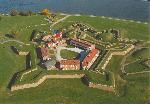
The Junior Ranger program is available in most National Parks and Historic Sites. Fort McHenry is titled with being both an National Monument but also an Historic Shrine. It is the only park to have both these titles.
During the War of 1812 after the British had captured Washington, DC and
was in the process of burning it to the ground, the British set their sites on Baltimore, a large port city. In the distance the people of Baltimore could see the orange glow of the flames just beyond the horizon to the south. They were fearful that the British would in turn burn Baltimore
too. They began to set up defenses to keep the British out. There were several military forts in the area but Fort McHenry was the most important due to its strategic location on the Patapsico River and jutting out into the river thus protecting the ports of Baltimore.
The fort is star-shaped and gives the best defense for

this peninsula to guard its territory. Lt. Colonal George Armistead was in charge of the fort. He was an interesting man with a lot of bravery and, well, guts!
When he knew that the British were coming he commissioned two flags to be made for the fort. Mary Pickersgill was commissioned to sew these flags. The first one was a 17x 25 foot flag. A storm flag it was said to be. The second was even larger and Armistead wanted "a flag so large that the British would have

no difficulty seeing it from a distance". It was this large flag that flew over the fort and will forever go down in history, being the most famous American Flag. Why is it famous you ask? Not only is it the flag that now hangs in honor at the Smithsonian Institute in Washington DC but is the

very flag that Francis Scott Key saw in the early morning light
knowing that the British had not taken Baltimore and that there was hope for our fledgling country after all. He was then inspired to write the words of our, now, national anthem.
This flag is huge!!

We also saw the guard house where they kept prisoners, the enlisted men's bunkhouse, the magazine, and the officer's quarters. We explored many cannons that were used during the War of 1812 and the Civil War. We also saw the statue of Orpheus, which is a bit odd. In 1913 Congress officially made "The Star Spangled Banner" the official National Anthem, although it had been sung as
such for many years. In 1914 they commissioned this statue to stand in honor of Francis Scott Key for writing the anthem. Looking at it in the time period of a return to Greek and Latin

roots and loving all things "classical" it fits. However, nowdays, I think they would have been better off having a statue of Francis Scott
Key himself. While his name and face are on many plaques around the fort, there is no statue of him.
No comments:
Post a Comment